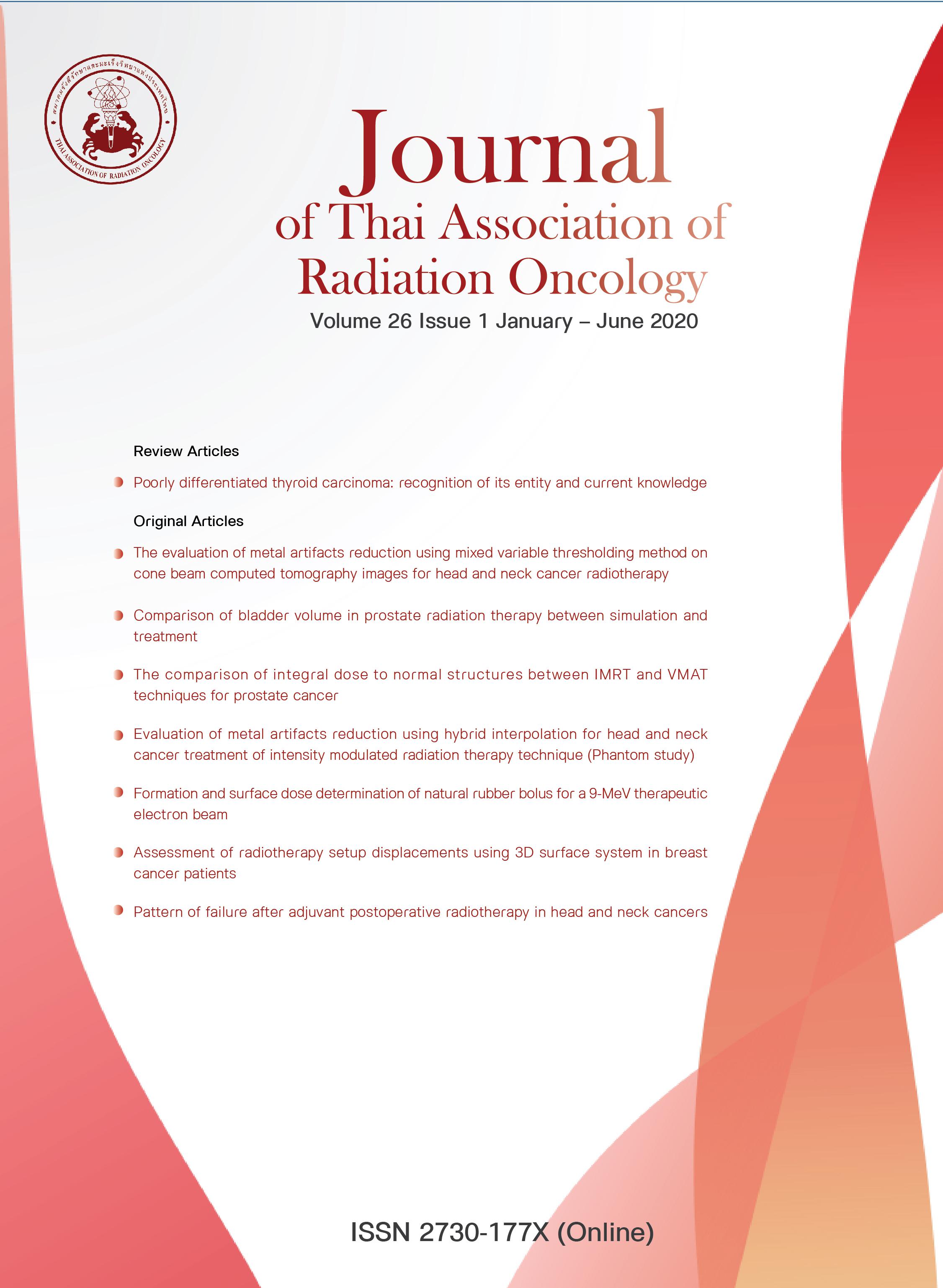Formation and surface dose determination of natural rubber bolus for a 9-MeV therapeutic electron beam
Keywords:
Bolus, Depth-scaling factor, Gafchromic EBT3, Natural rubberAbstract
Backgrounds: Bolus is a device used in electron beam radiotherapy to increase the surface dose. It may be made from natural or synthetic materials that have a density close to human tissue. Because of an expensive price, commercial bolus cannot be cut to a suitable size for each patient in clinical practice.
Objectives: The aims of this study were to form the in-house bolus with natural rubber and to determine the doses at surface of our bolus sheet.
Materials and Methods: The natural rubber and additional materials were mixed to mold the in-house bolus. The computed tomography (CT) number and physical density of our bolus have been obtained from the CT images and CT calibration curve, respectively. The surface doses were measured using Gafchromic EBT3 film for the 9-MeV electron beam from a Varian Clinac 23EX linear accelerator. The correction factors for scaling thickness of bolus were introduced.
Results: The natural rubber was successfully fabricated as a bolus sheets with the thickness of 0.32 and 0.52 cm. The physical densities of two bolus sheets were consistent to each other which equal to 0.87 g/cm3. The natural rubber bolus gave more measured surface dose than the commercial bolus that made of synthetic oil gel. The high differences of percentage surface dose were observed in the 0.5 cm thickness. For both the ~0.3 and ~0.5 cm thickness, the correction factors were closed to 1. After the correction, we found excellent agreement between the measured and calculated surface dose.
Conclusion: Natural rubber can be used as an alternative material to form the bolus sheet, because of its suitable property and density. Based on the correction factor from scaling thickness by its density, the surface doses equipped with the natural rubber bolus were equivalent to that with the synthetic gel bolus.
References
Clifford Chos KS, Perez CA, Brady LW. Radiation oncology: management decisions. Philadelphia: Lippincott Williams & Wilkins; 2011. P. 27.
Podgosak EB. Radiation oncology physics: a handbook for teachers and students. Vienna: International Atomic Energy Agency; 2005.
Park JI, Ha SW, Kim JI, Lee H, L J, Kim IH, et al. Design and evaluation of electron beam energy degraders for breast boost irradiation. Radiat Oncol. 2016; 11:112.
Canters RA, Lips IM, Wendling M, Kusters M, Van ZM, Gerritsen RM, et al. Clinical implementation of 3D printing in the construction of patient specific bolus for electron beam radiotherapy for non-melanoma skin cancer. Radiother Oncol. 2016; 12:148-53.
Malaescu I, Marin CN, Spunei M. Comparative Study on the Surface Dose of Some Bolus Materials. Int J Med Phys Clin Eng Radiat Oncol. 2015; 4:348-52.
Gunhan B, Kemikler G, Koca A. Determination of surface dose and the effect of bolus to surface dose in electron beams. Med Dosim. 2003; 28:193-8.
Vyas V, Palmer L, Mudge R, Jiang R, Fleck A, Schaly B, et al. On bolus for megavoltage photon and electron radiation therapy. Med Dosim. 2013; 38:268-73.
Benoit J, Pruitt AF, Thrall DE. Effect of wetness level on the suitability of wet gauze as a substitute for Superflab as a bolus material for use with 6 MV photons. Vet Radiol Untrasound. 2009; 50:555-9.
Seppala T, Collan J, Auterinen I, Seren T, Salli E, Kotiluoto P, et al. A dosimetric study on the use of bolus materials for treatment of superficial tumors with BNCT. Appl Radiat Isot. 2004; 61:787-91.
Chang F, Chang P, Benson K, Share F. Study of elasto-gel pads used as surface bolus material in high energy photon and electron therapy. Int J Radiat Oncol Biol Phys. 1992; 22:191-3.
Supratman AS, Sutanto H, Hidayanto E, Jaya GW, Astuti SY, Budiono T, et al. Characteristic of natural rubber as bolus material for radiotherapy. Mater Res Express. 2018; 5: 095302.
ยางธรรมชาติ, Available from: https://kb.psu.ac.th/psukb/bitstream/2010/9002/6/Chapter2.pdf
Cornish K. Biosynthesis of natural rubber (NR) in different rubber-producing species. USA: Woodhead Publishing Limited; 2014. P. 3-27.
Saion E, Sulaiman AA, Ahmad A, Wagiran H. Determination of Effective Atomic Number of Rubber. 1983; 6(3):95-8.
Tissue Characterization Phantom Model 467 User’s guide, Available from: https://www.gammex.com.
GAFChromicTM EBT3 film specification, Available from: www.gafchromic.com
Superflab bolus specification, Available from: www.rpdinc.com
Tissue-equivalent gel bolus specifications, Available from: https://civcort.com
Sorriaux J, Kacperek A, Rossomme S, Lee JA, Bertrand D, Vynckier S, et al. Evaluation of Gafchromic@ EBT3 films characteristics in therapy photon, electron and proton beams. Phys Med. 2013; 29:599-606.
Sipila P, Ojala J, Kaijaluoto S, Jokelainen I, Kosunen A. Gafchromic EBT3 film dosimetry in electron beams – energy dependence and improved film read-out. J Appl Clin med Phys. 2016; 17: 360-73.
Moylan R, Aland T, Kairn T. Dosimetric accuracy of Gafchromic EBT2 and EBT3 film for in vivo dosimetry. Australas Phys Eng Sci Med. 2013; 36:331-7.
Ulya S, Wibowo WE, Nuruddin N, Pawiro S.A. Dosimetric characteristics of gafchromic EBT3 film on small field electron beam. J Phys: Conf Ser. 2017; 851:012023.
Papaconstadopoulos P, Hegyi G, Seuntjens J, Devic S. A protocol for EBT3 radiochromic film dosimetry using reflection scanning. Med Phys. 2014; 41: 122101-1.
Mihailescu D, Borcia C. Water Equivalence of Some Plastic Materials used in Electron Dosimetry: A Monte Carlo Investigation. Rom Rep Phys. 2006; 58:415-25.
Jacob JL, d’Auzac J, Prevot JC. The composition of Natural Latex from Hevea brasiliensis. Clin Rev Allergy. 1993; 11:3255-37.
Knoos T, Nilsson M, Ahlgren L. A method for conversion of Hounsfield number to electron density and prediction for macroscopic pair production cross-sections. Radiother Oncol. 1986; 5:337-45.
Downloads
Published
How to Cite
Issue
Section
License
บทความที่ได้รับการตีพิมพ์เป็นลิขสิทธิ์ของวารสารมะเร็งวิวัฒน์ ข้อความที่ปรากฏในบทความแต่ละเรื่องในวารสารวิชาการเล่มนี้เป็นความคิดเห็นส่วนตัวของผู้เขียนแต่ละท่านไม่เกี่ยวข้องกับ และบุคคลากรท่านอื่น ๆ ใน สมาคมฯ แต่อย่างใด ความรับผิดชอบองค์ประกอบทั้งหมดของบทความแต่ละเรื่องเป็นของผู้เขียนแต่ละท่าน หากมีความผิดพลาดใดๆ ผู้เขียนแต่ละท่านจะรับผิดชอบบทความของตนเองแต่ผู้เดียว




